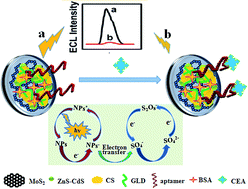A label-free electrochemiluminescence aptasensor for carcinoembryonic antigen detection based on electrodeposited ZnS–CdS on MoS2 decorated electrode
Abstract
In this work, a novel, simple and label-free electrochemiluminescence (ECL) strategy was designed for a sensitive carcinoembryonic antigen (CEA) assay on the basis of ZnS–CdS nanoparticle (NP)-decorated molybdenum disulfide (MoS2) nanocomposites. Layered-MoS2 nanocomposites with a large surface area were prepared with a facile hydrothermal method and used as an electrode matrix for subsequent ZnS–CdS NP electrodeposition. The ZnS–CdS NP decorated MoS2 electrode shows a higher ECL intensity than an electrode with only ZnS–CdS electrodeposition. For the fabrication of the aptasensor, chitosan was coated on a ZnS–CdS/MoS2/glass carbon electrode for CEA aptamer immobilization through a covalent coupling method. The ECL aptasensor for CEA detection exhibits a linear range from 0.05 to 20 ng mL−1 (R = 0.9975) with a low detection limit of 0.031 ng mL−1, and presents satisfactory specificity against some possible interfering proteins. Moreover, the method was successfully applied for CEA determination in human serum with recoveries of 80–111%, showing great promise for application in practice.


 Please wait while we load your content...
Please wait while we load your content...